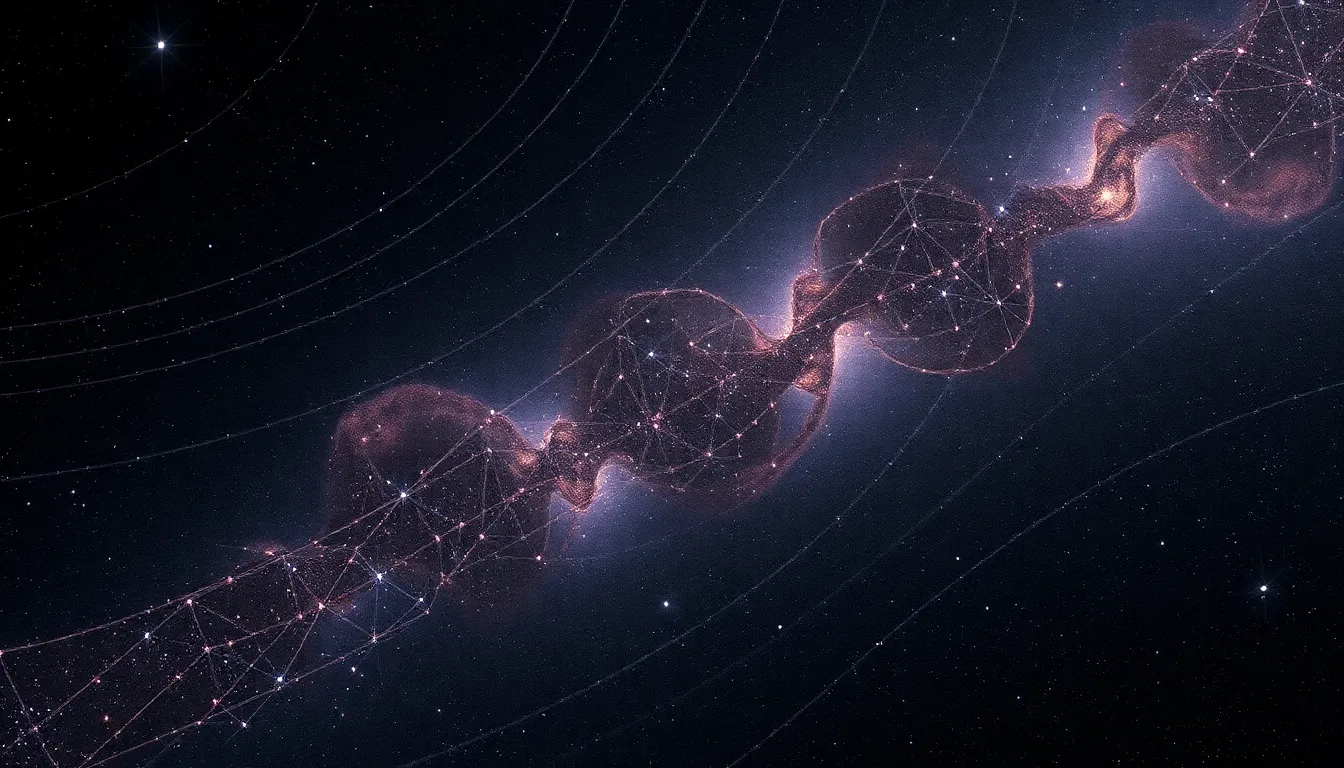To understand the universe, we must first understand its components, including the mysterious dark matter. This research aims to understand how dark matter behaves and whether it obeys the laws of gravity as we know them. The study focuses on how dark matter interacts with visible matter within galaxies to help us to understand dark matter dynamics.
Table of Contents
We Also Published
Recent studies delve into the enigmatic realm of dark matter, exploring its interactions within the cosmos. This research seeks to understand if dark matter aligns with the conventional laws of physics, particularly gravity. Let’s explore the depths of this cosmic puzzle and reveal what the latest findings tell us about the universe.
The Enigmatic Nature of Dark Matter
Dark matter, an invisible substance, constitutes a significant portion of the universe’s mass. It neither emits nor absorbs light, making it undetectable through conventional means. Its presence is inferred through its gravitational effects on visible matter, such as galaxies and stars. The distribution of dark matter across the cosmos forms a vast, intricate web, as illustrated by simulations and observations. This distribution is a crucial clue to understanding dark matter’s properties and behavior.
The Four Fundamental Forces
In the classical understanding of physics, four fundamental forces govern the universe: gravity, electromagnetism, the strong nuclear force, and the weak nuclear force. Gravity, the force that attracts objects with mass, is the most well-known. Electromagnetism governs interactions between charged particles, while the strong and weak nuclear forces operate within the atomic nucleus. These forces explain much of the observable universe, but dark matter presents a challenge.
Astrophysicists have long sought to understand the nature of dark matter. One intriguing hypothesis involves the potential existence of a fifth force, beyond the established four. Such a force could explain the unique behavior of dark matter. The search for this fifth force is ongoing, with scientists constantly refining their methods and analyses to uncover new clues. The challenge lies in detecting a force that interacts so subtly.
Testing Gravity’s Grip on Dark Matter
Researchers meticulously analyzed the movements of galaxies relative to the gravitational fields they experience. They compared these observations with predictions based on the assumption that dark matter interacts with gravity in the same way as visible matter. This involved complex calculations and simulations to map the distribution of dark matter and its influence on galactic dynamics. This approach allows scientists to assess whether dark matter behaves according to the established laws of gravity.
Analyzing Galactic Movements
The team examined how visible matter in galaxies moves under the influence of gravity. They compared these movements with the expected behavior if dark matter was also solely influenced by gravity. Any deviation from these expectations could suggest the presence of a fifth force affecting dark matter. Precise measurements of galactic motions are essential for detecting subtle differences in gravitational interactions. Analyzing these motions provides valuable insights into the dynamics of galaxies.
The study found that dark matter’s gravitational interactions with visible matter align with expectations, suggesting that dark matter is subject to gravity. A fifth force, if present, would have caused noticeable deviations in the galaxies’ movements. This supports the idea that dark matter behaves similarly to regular matter under gravity. The findings limit the potential strength of any fifth force that might exist. Further research and more precise measurements will be crucial in this field.
Constraints on a Fifth Force
The study places limits on the strength of a potential fifth force. If such a force exists, it cannot exceed 7% of the strength of gravity, or it would have already been detected in the current analyses. This iterative process of refining the upper limits of a fifth force is a characteristic of scientific inquiry. The researchers anticipate that future data from additional experiments will provide even more precise measurements, potentially enabling the detection of a force as weak as 2% of gravity.
Future Prospects and Data Analysis
Upcoming experiments promise to provide more precise data. Scientists are using increasingly sophisticated methods to study dark matter. These future studies may help to detect a fifth force. If this force is indeed there, it could reshape our understanding of the universe. Advancements in data analysis techniques will be critical to extracting meaningful insights from these experiments. The quest to understand dark matter continues, driven by the potential for groundbreaking discoveries.
Researchers are optimistic about the potential for future discoveries. These findings are pushing the boundaries of our knowledge. The potential for more precise measurements is a key driver of this optimism. The pursuit of understanding dark matter is a testament to the power of scientific curiosity and exploration. The journey to unravel the mysteries of dark matter promises to be a remarkable one.
Key Takeaways
The study’s findings suggest that dark matter primarily interacts with gravity, aligning with the current understanding of the universe’s fundamental forces. While the existence of a fifth force is not entirely ruled out, any such force must be exceedingly weak to remain undetected. The ongoing research and future experiments hold the promise of further refining our comprehension of dark matter and its place in the cosmos.
| Aspect | Details | Implications |
|---|---|---|
| Dark Matter | Invisible substance making up a significant portion of the universe’s mass; interacts gravitationally. | Influences galactic movements and structure, making it a key focus of study. |
| Fundamental Forces | Gravity, electromagnetism, strong and weak nuclear forces. | These are the known forces, but dark matter’s behavior may challenge our current understanding. |
| Fifth Force Hypothesis | Potential existence of an unknown force affecting dark matter. | Could explain discrepancies in dark matter’s behavior; limits set by recent studies. |
| Galactic Movement Analysis | Comparing observed galaxy movements with predictions based on gravity. | Provides evidence on how dark matter interacts with gravity. |
| Study Findings | Dark matter appears to primarily obey gravity, with a fifth force, if any, being very weak. | Supports current models and constrains possible fifth force interactions. |
Also Read
RESOURCES
- Dark Energy and Dark Matter | Center for Astrophysics | Harvard ...
- Scientists code Milky Way twin galaxies to better understand dark ...
- Dark matter | CERN
- Dark Matter - NASA Science
- Dark matter - Wikipedia
- Dark matter's odd behavior baffles astronomers | UC Davis
- Why do most scientists believe that dark matter exists, as opposed to ...
- News CFHT - Dark Matter Core Defies Explanation
- Does dark matter behave in any way like a gas, dust, or plasma, and ...
- Studies shed light on dark matter by simulating twins of our Milky ...
- Do “Completely Dark” Dark Matter Halos Exist?
- Survey of 26,000 dead stars confirms key details of extreme stellar ...
- Dark matter does not defy gravity, study suggests
- An N-body/hydrodynamical simulation study of the merging cluster ...
- Dark Matter, Dark Reuse, and the Irrational Zeal of a Believer ...
From our network :
- Economic Importance of Soybeans in America: The $60 Billion Crop That Feeds the World
- Bitcoin price analysis: Market signals after a muted weekend
- The Diverse Types of Convergence in Mathematics
- Limits: The Squeeze Theorem Explained
- Optimizing String Concatenation in JavaScript: Template Literals, Join, and Performance tips
- Bitcoin Hits $100K: Crypto News Digest
- Optimizing String Concatenation in Shell Scripts: quotes, arrays, and efficiency
- Limit Superior and Inferior
- JD Vance Charlie Kirk: Tribute and Political Strategy








0 Comments